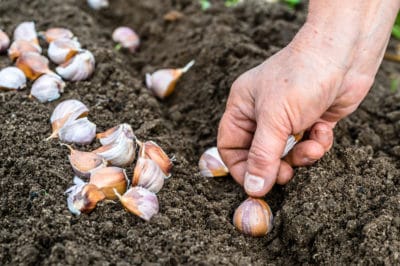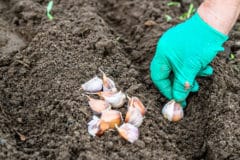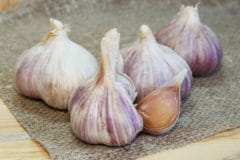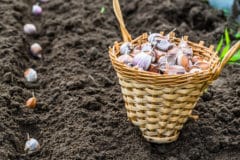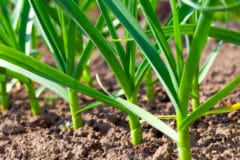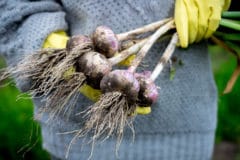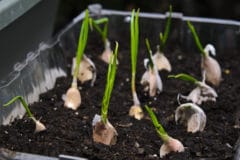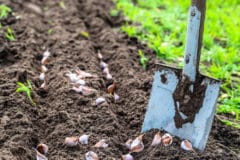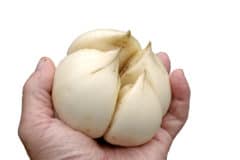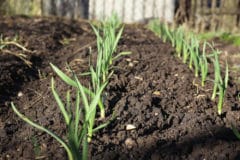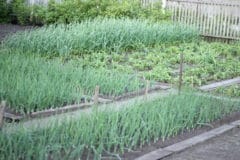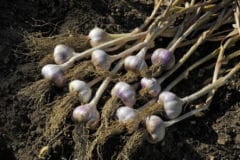Should Garlic be Planted in Spring or Fall?
It’s not really an either/or question. In most areas, garlic can be planted in the spring as well as the fall. It takes longer to come to maturity if fall-planted, which might tie up space in the garden. Many gardeners grow both a spring and a fall crop. In warm-winter areas, it is definitely best grown as a fall crop.
Can I Plant Garlic in Summer?
You can plant garlic in the summer, but it’s not likely to do very well. Garlic is basically a cool-season crop. While you might be able to make a crop with summer planting, it means you’ll be harvesting in late fall, when wet weather is likely. This makes it harder to cure the garlic, which affects storage. Summer-planted garlic may not be as flavorful, either.
What Garlic Varieties Should I Plant?
You can choose between hardneck and softneck garlic. The latter stores better, while the former has larger cloves and more complex flavors. Here are some possible choices:
- Carpathian – spicy Polish hardneck.
- Georgian Red – hardneck, stores well.
- German Extra-Hardy – mild flavored, stores well.
- Siskiyou Purple – softneck, does well in hot areas.
- Spanish Roja – full flavored hardneck.
How Do I Prepare the Soil for Garlic?
Garlic is a heavy feeder. It also grows better in loose, friable soil. Work up the soil by digging or with a rototiller. If you have heavy clay, add sand or organic matter to make the soil more friable. For sandy soil, add lots of peat, aged manure or well-rotted leaf mold. Water several days before you actually plant so soil is moist at least six inches down.
How Do I Plant Garlic?
Once the soil preparation is done, planting garlic is easy. Separate the cloves, but don’t remove the papery wrappers. Make a trench about one or two inches deep. Plant individual cloves one inch deep and cover with soil. Space plants four to six inches apart. For rows, space plants about afoot apart. For intensive planting, space all plants four to six inches apart.
When Should I Plant Garlic in Containers?
Garlic can be planted in containers at the same times you would normally plant in the ground – early spring or late fall. With containers, you need to be much more careful of drainage in the winter, as water-logged garlic can rot. The opposite is true with spring-planted garlic in containers. As the weather warms up, check your pots frequently to make sure your garlic isn’t going short on water.
Why Isn’t My Fall-Planted Garlic Growing?
Garlic is actually more similar to flowering bulbs than a vegetable or an herb. Fall-planted garlic – like daffodils – goes through a semi-dormant period when it is developing roots. Since all the activity happens below ground, you won’t see anything. If you’re really worried, you could dig up a clove to check, but the sprouts normally won’t start to appear until spring.
How Do I Prepare to Plant Garlic in Fall?
Two of the most important tings you can do for fall-planted garlic are to build soil fertility and make sure the soil drains well. Your garlic will be doing some growing underground through the winter and needs to be able to have nutrients from well-aged manure, rotted leaf mold or a balanced 10-10-10 organic fertilizer readily available. These materials will also add humus and improve drainage.
Should I Plant Garlic Before or After Companion Plants?
It depends on the plant and your purpose. If you have soil nematodes and you’re planting marigolds to get rid of them, you should plant the flowers the year before you grow garlic. If you’re planting garlic in an orchard to repel pests, you can either plant the garlic with your new fruit trees or plant later around mature fruit trees. In most other cases, the timing for companion plants doesn’t really matter.
Does When I Plant Affect Harvest?
Planting time definitely affects harvest. Fall-planted garlic has a period of semi-dormancy through the winter. This means you must add about 50 to 60 days to your expected maturity dates. For example, garlic with an expected maturity date of 100 days will actually take about 160 days when fall-planted. Spring-planted garlic, however, will be ready near the expected maturity date.
